

Unsorted Navy.
Expeditionary warfare. Expeditionary warfare in the ancient world[edit] Empire of Alexander the Great The raiding tactics were expanded into the more complex expeditionary warfare operations by Alexander the Great who used naval vessels for both troop transporting and logistics in his campaigns against the Persian Empire.

The next exponents of expeditionary warfare in the ancient world of the Mediterranean Basin were the Carthaginians who introduced two entirely new dimensions to the use of naval forces by staging not only operations that combined naval and land troops, but also eventuated in combining strategic multi-national forces during the land phase of the operation when Hannibal in his most famous achievement at the outbreak of the Second Punic War marched an army, which included war elephants, from Iberia over the Pyrenees and the Alps into northern Italy. Expeditionary maneuver warfare.
Expeditionary maneuver warfare (EMW) is the current concept that guides how the United States Marine Corps organizes, deploys and employs its forces.
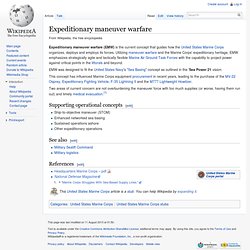
Utilizing maneuver warfare and the Marine Corps' expeditionary heritage, EMW emphasizes strategically agile and tactically flexible Marine Air Ground Task Forces with the capability to project power against critical points in the littorals and beyond. EMW was designed to fit the United States Navy's "Sea Basing" concept as outlined in the 'Sea Power 21 vision.
This concept has influenced Marine Corps equipment procurement in recent years, leading to the purchase of the MV-22 Osprey, Expeditionary Fighting Vehicle, F-35 Lightning II and the M777 Lightweight Howitzer. Two areas of current concern are not overburdening the maneuver force with too much supplies (or worse, having them run out) and timely medical evacuation.[1] Supporting operational concepts[edit]
Sustained Operations Ashore. Seabasing. CDI_STOM. Marine Air-Ground Task Force. The Marine Air-Ground Task Force (MAGTF, pronounced mag-TAFF) is a term used by the United States Marine Corps to describe the principal organization for all missions across the range of military operations.
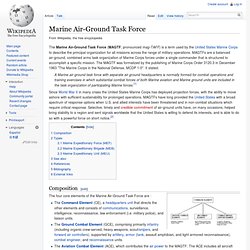
MAGTFs are a balanced air-ground, combined arms task organization of Marine Corps forces under a single commander that is structured to accomplish a specific mission. Amphibious ready group. An Amphibious Readiness Group (ARG) of the United States Navy consists of a Navy element—a group of warships known as an amphibious task force (ATF)—and a landing force (LF) of United States Marines (and occasionally United States Army troops), in total about 5,000 people.
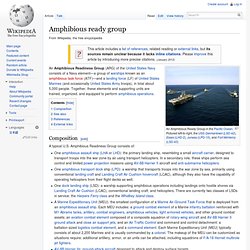
Together, these elements and supporting units are trained, organized, and equipped to perform amphibious operations. Composition[edit] A typical U.S. Amphibious Readiness Group consists of: Marine expeditionary unit. A Marine Expeditionary Unit (MEU, pronounced Myuu), formerly called Marine Amphibious Unit (MAU), is the smallest Marine air-ground task force (MAGTF) in the United States Fleet Marine Force.[1] Each MEU is an expeditionary quick reaction force, deployed and ready for immediate response to any crisis.[2] Attributes[edit] The MEU is unique in that its air and ground combat elements are combined with a logistics combat element under one commander; other services do not unite the command of air and ground forces until much higher command levels.

The MEU's ground combat element also combines artillery, light armor and tanks at a much lower level than was common in the Army until the development of the brigade combat team early in the War on Terror, with a similar concept, the combat command, being utilized in World War II. Dock landing ship. A dock landing ship (also called Landing Ship, Dock or LSD) is an amphibious warfare ship with a well dock to transport and launch landing craft and amphibious vehicles.[1] Some ships with well decks, such as the Soviet Ivan Rogov class, also have bow doors to enable them to deliver vehicles directly onto a beach (like a Landing Ship, Tank [LST]).
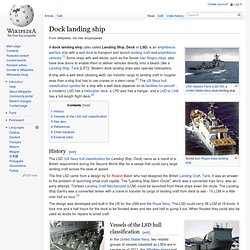
Amphibious transport dock. An amphibious transport dock, also called a landing platform/dock (LPD), is an amphibious warfare ship, a warship that embarks, transports, and lands elements of a landing force for expeditionary warfare missions.[1] Several navies currently operate this kind of ship.
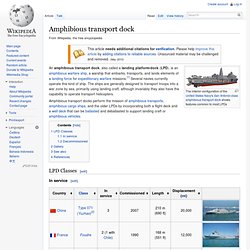
The ships are generally designed to transport troops into a war zone by sea, primarily using landing craft, although invariably they also have the capability to operate transport helicopters. Amphibious assault ship. An amphibious assault ship (also referred to as a commando carrier[note 1] or an amphibious assault carrier) is a type of amphibious warfare ship employed to land and support ground forces on enemy territory by an amphibious assault.[1] The design evolved from aircraft carriers converted for use as helicopter carriers, but includes support for amphibious landing craft, with most designs including a well deck.
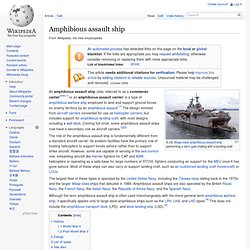
Coming full circle, some amphibious assault ships now have a secondary role as aircraft carriers.[2][3] The role of the amphibious assault ship is fundamentally different from a standard aircraft carrier: its aviation facilities have the primary role of hosting helicopters to support forces ashore rather than to support strike aircraft. Landing helicopter dock. USN ship classes that precede and follow the ships classed LHD are designated as LHA or Landing Helicopter Assault and are interchangeable with LHDs, they also have well decks with the exception of the first two America class ships, LHA-6 and LHA-7 which take the space for larger aviation facilities.[5]
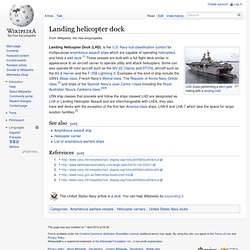
Landing Helicopter Assault. LHA, for Landing Helicopter Assault, is the United States Navy's hull classification symbol for the general purpose helicopter-carrying amphibious assault ships of the Tarawa and the future America classes.
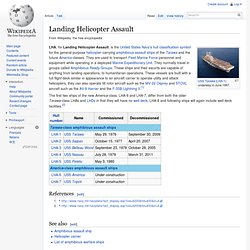
They are used to transport Fleet Marine Force personnel and equipment while operating in a deployed Marine Expeditionary Unit. They normally travel in groups called Amphibious Ready Groups. These ships and their escorts are capable of anything from landing operations, to humanitarian operations. These vessels are built with a full flight deck similar in appearance to an aircraft carrier to operate utility and attack helicopters, they can also operate tilt rotor aircraft such as the MV-22 Osprey and STOVL aircraft such as the AV-8 Harrier and the F-35B Lightning II.[1] References[edit]